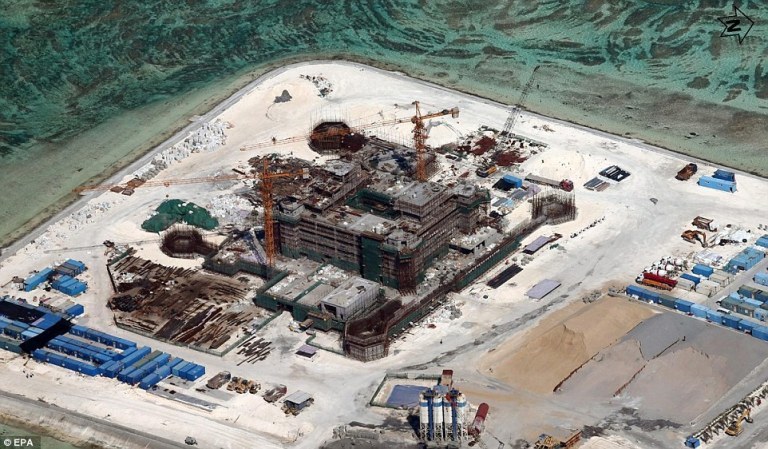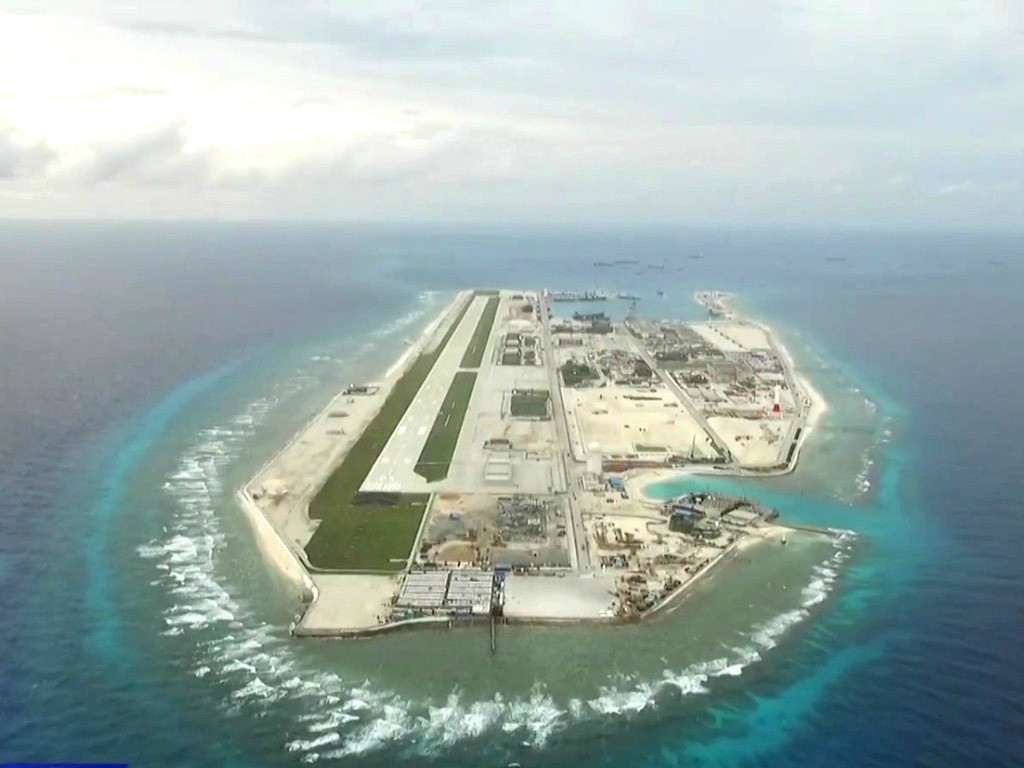
A photo taken of works built by China on Gaven Reef on February 19, 2015 by the Philippine army.
Argument: The Philippines violated commitments on dispute settlement by negotiation that were stipulated in the Declaration on the Conduct of Parties in the East Sea (DOC) and other agreements.
China said that the Philippines and China, through the DOC and the other bilateral agreements between the two countries, had committed to resolve disputes in the East Sea (internationally known as the South China Sea) through negotiations only. Therefore, the Philippines’ case against China at the PCA was against the commitments made by the Philippines, and China did not recognize the whole proceedings, as well as jurisdiction and any verdict of the PCA.
In the ruling on the jurisdiction, the PCA affirmed that the DOC as well as bilateral agreements between the Philippines and China are not legally binding documents. [1] Thus, the Philippines’ use of the dispute settlement mechanism of the UN Convention on the Law of the Seas (UNCLOS) to settle disputes with China in the East Sea through the PCA did not violate the provisions of the UNCLOS, as well as the obligations of the Philippines under international law. The PCA is absolutely competent in resolving this dispute.
The photo taken on February 19, 2015 by the Philippine military shows the construction scale of China on the Gaven Reef in Truong Sa (Spratlys Islands), Vietnam. Photo: EPA
In addition, Article 288 of the UNCLOS stipulates that if there is any dispute between the parties on the jurisdiction of the PCA, the PCA shall have full power to consider whether the PCA has jurisdiction or not. On October 29th 2015, the Court confirmed that it has jurisdiction to resolve a number of requests in the petition of the Philippines. On July 12th 2016, the PCA continued to assert its jurisdiction over the remaining requirements, as well as to draw conclusions about the content of each issue.
The PCA also emphasized that its ruling is final and legally binding on the parties involved in the case - the Philippines and China. Therefore, the Chinese statement of objections and their not adhering to the PCA’s ruling do not affect the legal validity of the decision. This act is contrary, if not a flagrant violation of international law and commitments that China has made as a member of UNCLOS.
Other arguments

In addition, there are also other arguments of pro-China scholars focusing on the legitimacy of the PCA. For example, the argument attacking the former director of the International Tribunal on the Law of the Sea (ITLOS), judge Shunji Yanai. They said that Mr. Yanai is a Japanese and the one who chose the arbitrators for the case between the Philippines and China, so it would be certainly unfair and impartial.
Also there are the arguments that as the PCA had only five arbitrators, their ruling is not persuasive as the rulings given by other International Courts as the ITLOS (21 judges) or the International Court of Justice (ICJ) (15 judges). But those who made this argument have forgotten that China’s refusal to appear at the Court led to the two legal consequences.
China would have been able to accept the claim of the Philippines and select the ITLOS or the ICJ to resolve the dispute. But China chose to be absent from the Court. Therefore, pursuant to Article 287 of the UNCLOS, a party in the dispute can unilaterally lodge its claim to the International Court. The court that accepts the case would be the Court of Arbitration under the Annex VII.
China would have been able to solve the dispute with the Philippines at the Court of Arbitration under Appendix VII and China would have had the right to select the arbitrators as its wish. But China chose to boycott the case. Thus, as defined in Article 3 of Annex VII of UNCLOS, the director of the ITLOS has to choose arbitrators because of the absence.
And up to now, China has made statements and actions representing views of not complying with a ruling made by the PCA on July 12, 2015. This behavior of China is justified that under Article 38, the regulation on the PCA is not in main sources of international law, so if China does not obey the ruling of the PCA, it does not mean that it is breaking international law. Legally, this argument is completely wrong.
As noted above, Article 296 of UNCLOS provides that the judgment of the International Court or the Court of Arbitration established under the UNCLOS (Annex VII) shall be final and binding to the parties mentioned in the ruling. China, though it did not appear at the Court, is still a party in the ruling, therefore it is obliged to implement this ruling. Otherwise, China will violate Article 296 of UNCLOS - this is a source of international law; thus, China does not comply with international law.
Finally, there is an argument that if China withdraws from the UNCLOS, China can avoid the implementation of the PCA’s ruling. This argument is hardly persuasive under the following two points. Firstly, under Article 317 of UNCLOS, member states have the right to denounce UNCLOS, but the denunciation does not include an obligation to implement the ruling in at least one year after it makesa declaration of withdrawal.
Secondly, as a member of UNCLOS, China benefits greatly from the provisions of UNCLOS, especially the institutions of the exclusive economic zone (EEZ) and the continental shelf. Thus, it is likely that China will not refuse these benefits only to evade the implementation of the ruling made on July 12, 2016
Conclusion

The arguments against the establishment of, competence, and the ruling and the legitimacy of the Court of Arbitration Annex VII solving the lawsuit between the Philippines and China from China and pro-China scholars may be dismissed logically and legally under international law. The PCA was very careful to split the proceedings into two different sessions. One session was held only to consider jurisdiction and the other to settle the dispute.
The final ruling of more than 500 pages thoroughly resolves each claim of the Philippines, showing the details of the court, and the coherence in each arguments of the judges. Therefore, China’s arguments against the court and its ruling show an attitude of disregarding justice and the superficial study of international law of the sea in particular and international law in general.
Pham Ngoc Minh Trang
Faculty of International Relations, HCM City University of Social Sciences and Humanities
-----
[1] The ruling on competence, paragraphs 229, 289.